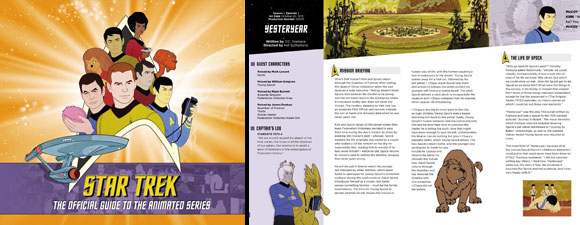Retro Review: How Sharper Than a Serpent’s Tooth
5 min readAn ancient alien astronaut who visited Earth and was worshipped as a god takes Kirk as a specimen for a collection of species he’s influenced.
Plot Summary: Starfleet dispatches the Enterprise to follow an ancient space probe which scanned Earth, sent data about the planet into deep space, then self-destructed. The probe has left a propulsion trail which leads the Enterprise to a ship that uses a force field to take the form of a winged serpent. Ensign Walking Bear identifies the shape as that of the ancient Mesoamerican god Kukulkan, who appeared to the Aztec and Maya civilizations. A disembodied voice announces that the god is pleased to be recognized but that humans must face a test to ensure the survival of their race, which appears to have forgotten their ancient benefactor. Moments later, Kirk, McCoy, Scotty, and Walking Bear are transported from the Enterprise to what appears to be a massive city with elements from many ancient Earth cultures. The officers conclude that they are meant to summon Kukulkan using a crystalline device atop a pyramid, which they activate by redirecting sunlight. Kukulkan appears, but is angry that the Enterprise fired on his ship and has not forgiven humans for forgetting that he is their master and they should practice peace. He takes the crewmembers to his collection of alien specimens from the worlds he has influenced, kept happy in cages that function as holograms to distract them. Meanwhile, Spock has the Enterprise fire on Kukulkan’s ship to free the Starfleet officers. Seeing Kukulkan distracted, Kirk’s men free a Capellan power cat from its cage to give the Enterprise and the away team an advantage. Kukulkan is forced to accept that his children have outgrown his wish to oversee them. Reluctantly, Kukulkan lets them go.
Analysis: Take “Who Mourns for Adonais” and “The Menagerie” smashed together with a bit of “The Apple” and some sloppy prehistory, stick in a Shakespearean quote like “The Conscience of the King” and toss in a Native American crewmember in the name of Infinite Diversity in Infinite Combinations, and you end up with “How Sharper Than a Serpent’s Tooth,” which has entertaining visuals but not much else going for it. I don’t much like science fiction stories which human breakthroughs are credited to alien intervention, particularly on a show like Star Trek which has always insisted that human willpower has been a driving impetus for innovation and intellectual development rather than a brute force that needed a benevolent deity to rein it in. So I’m not predisposed to like Kukulkan in the first place, particularly since this isn’t the Mayan deity associated with the sun god but a mishmash of dragon legends taking credit for nearly all of humanity’s early triumphs. I understand that the writers didn’t want to commit the bigoted slight of suggesting that Native American pyramids couldn’t have been built without divine intervention while other architectectural wonders might have arisen purely from human efforts – the much more recent fourth Indiana Jones film is infuriating in this regard – but in an effort to make the divine intervention universal, the show erases everything that’s unique and interesting about the Mesoamerican cultures to whom Kukulkan was important.
The same problem occurs with Ensign Walking Bear, who is in many ways a prototype for Voyager‘s Chakotay. In an effort to represent more than one Native American culture, the show really doesn’t present any; we’re told that he’s a Comanche and a student of ancient Earth history, but he doesn’t tell us where his own name comes from, let alone what appealed to him about joining Starfleet and practicing the problematic Prime Directive as an outsider approaching indigenous populations. The character’s role could just as easily have been filled by Sulu, who might know something about ancient Japanese dragon legends because of the interest in ancient Japanese culture we were shown in early original series episodes. It’s aggravating that Scotty’s Highland heritage and McCoy’s Southern pride remain entirely recognizable from their 20th century stereotypes, but we know more about Vulcan culture of the future than we do about African, Asian, or Native American regional differences and developments. Given Kirk’s apparent ignorance of all South American mythology, though he was familiar enough with Apollo, it seems likely that Kukulkan knows more about Ensign Walking Bear’s heritage than most people on Earth. I’m surprised none of the historians and anthropologists on the Enterprise want to stay and study this influential alien, to learn how prehistoric meddling without any sort of Prime Directive affected the course of Earth’s development.
I’m not going to deny the appeal of a giant serpent-shaped ship, and the pseudo-Mayan elements on the dragon and pyramid are nicely done. There are references to the Mayan calendar with the infamous end of the world date that will have passed by Kirk’s era, and to the unique features of Mesoamerican building which Walking Bear believes mean the Mayans came closer to any other humans to building a city according to Kukulkan’s specifications, though his fantastic holographic city also includes Egyptian and Japanese elements. Still, I don’t understand why Kukulkan tries to goad their hate when he claims he only taght them peace, and I’m completely mystified that he thinks it’s a good idea to show them his zoo collection of specimens from other worlds. After all that multiculturalism, we’re left with a quote from King Lear about thankless children and another god defeated by Kirk, plus a maybe-joke about how aliens who visited Vulcans left the planet much wiser. I wish “How Sharper Than a Serpent’s Tooth” felt more like an homage to the various Star Trek episodes from which it borrows rather than a recycled pastiche; I know that it won the animated series an Emmy Award, but the serpent in space is the only aspect I really enjoy remembering.







I always liked this one. One of animated Trek’s best outings, and one that felt the most like a classic Trek episodes.
There’s a reason it won the series an Emmy.
You may want to note that this song was written by American Indian Russell Bates.
I meant episode, not song, Duh!
I don’t think I’ve seen TAS since it originally aired, but I guess I saw all of them. These reviews bring it all back. I didn’t really care for TAS then, so I guess I wouldn’t now. I haven’t been counting but only one or two of these reviews seem to be positive.
I wish the reviews mentioned who wrote each episode, even if background information about the person cannot be provided.